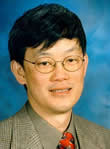Enterprise
Architect and Strategist, Intel Solution Services, USA
|
  Biography Biography
• Enterprise
Architect for Intel Solution Services. 25-year career
includes 21 years with Intel Corporation spanning OS
design & architecture,
software engineering, platform definition and business
development with occasional teaching stints at the
Oregon Graduate Institute, Portland State University
and the University of Costa Rica.
• Served as a lead architect and Task Force
Chair during the foundation of Intel® Solution
Services in 1999.
• Authored over 30 papers, white papers and articles
in subjects ranging from High Performance Computing
to Web services
• Ph.D. and M.S. in Electrical Engineering and Computer
Science from Purdue University
• President, Director & Founder of The Neighborhood
Learning Center, a non-profit educational organization
|
 Presentation
Presentation
The Concept of Federated Technology Development
Developing a product today is a long and arduous process:
Science and technology principles are applied to develop
a proof of concept. The concept is engineered into a prototype,
a precursor of the final, shipping product. The prototype
is then scaled into a manufacturing process to build a product
in large quantities. At this point the business and marketing
phase begins to place the new product in the home market.
A supply chain needs to be built. When a market has been
identified for the product, a customer relationship infrastructure
is built as well. It is only at this point where considerations
for selling the new product in international market begin.
The process for placing a product internationally can be
as long as building it in the first place because the steps
needed to develop the product in the home market need to
be retraced when building an international market. Furthermore,
technology developed for the home market may not be a good
fit for the target international market and may require further
refinement, at additional time and cost.
The traditional way of manufacturing does not take two important
factors today into account: the rapid pace of technology
adoption and the fact that most economic activity today takes
place today through collaborative relationships spanning
the globe. Some attempts have been made to speed up the manufacturing
processes, such as the just-in-time (JIT) methodologies.
The fact remains that technology development is still very
much a centralized, serial and monolithic process.
We examine strategies used by companies today to accelerate
the development and diffusion of technology, such as the
establishment of regional design centers and outright technology
purchases by host countries. These strategies have drawbacks
that leave much potential for business agility on the table.
A parallel, decentralized approach for technology development
is proposed that strives to develop features that address
the needs of regional markets from the beginning as a way
of eventually shortening the development as well as the delivery
pipeline. This is the Federated Technology Development (FTD)
approach.
The paper goes through a number of examples that the authors
propose as perhaps fortuitous expressions of FTD with an
examination of changes in culture and traits in organizations
needed to make it happen.
The last section is forward looking, where we attempt to
move from serendipitous to predictable results. We analyze
processes in the industry occurring today with the goal of
attaining the best business outcomes using the FTD principles
previously laid out.
 return
to program return
to program
|